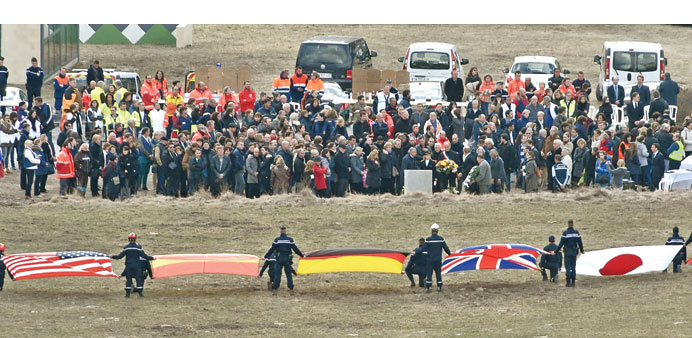DPA/Paris
Left alone in the cockpit of Germanwings flight 4U9525, co-pilot Andreas Lubitz manually began a descent procedure and did not respond when his pilot and crew pounded on the locked door as the airplane slammed into a mountainside in France.
Those are the findings announced yesterday by the prosecutor of Marseilles, Brice Robin, who was initially charged with investigating a case of involuntary homicide after the flight carrying 150 people crashed en route to Dusseldorf from Barcelona.
Calling it “the most terrible event” in Lufthansa history, the head of Germanwings parent company Carsten Spohr said that the company was “speechless”, echoing shock expressed across Europe at the prosecutor’s chilling findings.
Robin said the nature of the investigation changed as it became clear that the crash resulted from a series of conscious decisions on the part of Lubitz to bring down the plane.
Breathing normally in a way that indicated consciousness, Lubitz did not respond as knocking on the locked cockpit door became more insistent and alarms began to sound as the plane neared the ground.
He also remained silent despite multiple attempts from the air traffic controller to elicit information.
It was likely that the pilot left to use the toilet when the automatically-locking door closed, Robin said.
Someone inside the cockpit has to push a button for the door to open again.
Lubitz may also have pressed a button to lock the door when the pilot tried to re-enter the cockpit, Spohr said.
The plane had two access codes on its cockpit door, a normal one and an override code that would allow crew entry from outside if there were no reaction from inside the cockpit.
But the override code can be blocked from the cockpit.
According to the audio file of the plane’s 10-minute descent, it seemed most passengers were unaware that something was awry until just before the aircraft’s impact, when the knocking on the door became frantic and screams could be heard in the cabin.
There is no indication that the crash was a terrorist attack, Robin said, adding that the act seemed suicidal but couldn’t be characterised as a suicide when there were so many other victims.
Details slowly emerged about the young man, but his motives remained unclear.
Earlier, German authorities confirmed to DPA that he was from Montabaur in Rheinland-Pfalz, near Frankfurt, and Dusseldorf city authorities confirmed his age as 27 years old, instead the previous reported 28.
“His performance was without criticism. Nothing was striking,” said Spohr.
While Lubitz had interrupted his training, he “went through all the medical tests and checks successfully. He was fit for flying without any restrictions”.
Lubitz began working for Germanwings in September 2013 and he had 630 flying hours under his belt.
German authorities conducted a background check on Lubitz and found nothing out of the ordinary, Interior Minister Thomas de Maiziere said.
Lubitz’s home in Dusseldorf was searched as authorities looked for clues into the motive behind the crash.
De Maiziere said intelligence records, the national police database and Lufthansa’s own records were reviewed shortly after the crash, but nothing noteworthy was found.
“We checked the rest of the crew and the passengers for signs of terrorism or any other security concerns, and they all came up negative,” he said.
Lubitz’s family and the family of his fellow pilot have travelled to France and were informed of the prosecutor’s findings.
The families of victims, many of whom gathered in the afternoon at a site near the location of the crash, were also informed.
German Chancellor Angela Merkel and Spanish Prime Minister Mariano Rajoy, leaders of the two countries that were home to most of the victims, both said they were shaken by the account.
“This news shocks me very deeply,” Merkel said, adding that there were no explanations for the tragedy. “It goes beyond anything I would have imagined.”
“I wonder when this nightmare will end,” said Urlich Wessel, the head of a school that lost two teachers and 16 students in the crash. “This is much, much worse than we thought. It leaves us angry, baffled and stunned.”
Many of the findings come from a file that was retrieved from one of the plane’s two black boxes, which contained a voice recorder.
It was recovered at the crash site, where disintegrated debris from the aircraft covers a four-hectare section of mountain face in a remote area of southern France.
Authorities are still looking for the second black box containing a flight data recorder.
French President Francois Hollande said a badly damaged casing found on Wednesday did not contain the device.
Searchers were facing extreme conditions in the recovery efforts yesterday as they sought clues in strewn across a high-altitude mountain that is difficult to access by foot.
“The work is extremely difficult, the terrain is dangerous, it is steep and slippery,” the head of the mountain rescue teams, Olivier Cousin, told DPA.
Officials with the US Federal Bureau of Investigation offered the agency’s help to European investigators looking to piece together information about the crash.
Investigators from France, Germany and the international police force Interpol are already on site.

Relatives of the Germanwings Airbus A320 crash victims gather by a stele during a wreath-laying and remembrance ceremony as rescuers (Front) hold flag


